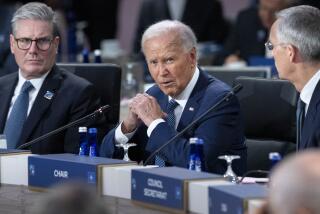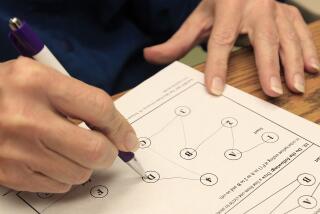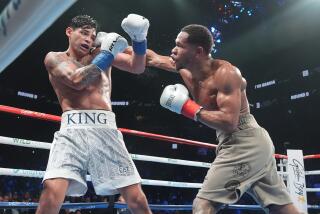Poll Wins Appeal After Failing Test : Boxer Gets 4th Chance in Neurological Exam
- Share via
North American Boxing Federation super bantamweight champion Jesus Poll is not having much trouble in the ring these days. His big problem is just getting into one.
Poll, scheduled to defend his title Friday at the Reseda Country Club, may be prevented from doing so because of his repeated inability to pass a neurological test mandated by the California State Athletic Commission.
Poll first failed the test, designed to determine possible brain damage, several months ago. That would normally disqualify him from fighting. But because his handlers maintained that the test results may have been indirectly affected by a language barrier, Poll was allowed to go ahead with a scheduled match at the Country Club before taking a second test.
Poll, a native Venezuelan, has relocated in North Hollywood after signing with the Ten Goose Boxing Club. But he has not yet learned to speak English. Although an interpreter is used for the tests, Poll’s handlers questioned how much their fighter had understood and how much of a cultural barrier may have been involved.
About 10% of the fighters who take the neurological test fail, but, according to a commission official, a large majority of those are either from rural areas of Mexico or from Central or South America.
After beating Miguel Juarez on a decision in April, Poll took a second test and this time the results were inconclusive, according to Marty Denkin, assistant executive officer of the commission.
Last month, Poll went to Nevada, where neurological tests are not required, and beat Louie Espinoza to win the NABF title.
Poll then took a third test and failed, but it was felt by commission officials that “extenuating circumstances” also may have rendered those results useless. The circumstances, it has been learned, involved a dispute between Poll’s handlers and the doctor over the test procedure.
So now commission officials have agreed to let Poll take yet another test next week, the results of which are expected to determine whether he will be allowed to defend his title Friday against Julian Solis in a bout scheduled to be shown nationally on the ESPN cable network.
“As far as we’re concerned, we have two private doctors who passed Jesus and two others have not passed him,” Poll’s manager, Dan Goossen, said. “What it boils down to is that we will take every measure to ensure ourselves that Jesus Poll is perfectly normal to perform at his trade.”
Next week’s test will be conducted by a private neurologist certified by the state. The results will be turned in to the commission.
“Jesus Poll has failed a series of tests,” Denkin says, “but how conclusive those results are has been challenged. We are now trying to accommodate all parties under the proper appeal procedure.”
Denkin describes the testing as a “preventive procedure.” It is given, he explained, “to see if there are signs the fighter has brain damage, if a fighter is about to get brain damage, or if he is at a point that could lead to brain damage.”
“A CAT scan or an EKG can only show damage that is already there. We want to try to remove fighters from the boxing game before serious signs appear, such as punch drunkenness, so he can lead a useful life outside the ring.”
A fighter is required to take the neurological test annually but can be required to take it again in the interim by commission officials if he absorbs an unusual amount of punishment in the ring or is on the receiving end of several knockouts.
While the 23-year-old Poll is unbeaten at 17-0-2 and does not appear to have been hurt much in the ring, at least in his recent fights, he did have 200 amateur fights before turning pro.
The neurological test is not an IQ test. One portion of the examination involves reflexes. Another involves questions such as: Name five farm animals in 45 seconds.
The final portion involves drawing a geometric figure such as a triangle, pulling the drawing away and then asking the subject to draw the same figure.
“They don’t have to be Vincent van Gogh,” Denkin said, “to draw the pictures. But if they can’t remember what they just looked at, or if the doctor draws a square and then they draw a circle, you’ve got some problems.
“It shows they are not retaining what they see.”
More to Read
Go beyond the scoreboard
Get the latest on L.A.'s teams in the daily Sports Report newsletter.
You may occasionally receive promotional content from the Los Angeles Times.










